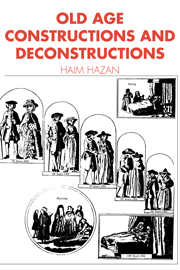Introduction: towards knowledge of old age
Published online by Cambridge University Press: 05 June 2012
Summary
Human experience is shaped by human constructs. Through a complex set of social arrangements, cultural codes are deciphered, negotiated and sustained as conceptual devices for interpreting situations, values and norms. These devices inform a structure of social knowledge which extends throughout all areas of life and permeates the products, tangible and intangible, of human consciousness. Actions and interactions, thoughts and utterances, artefacts and works of art are the language in which such social knowledge is articulated. Concepts, therefore, are not merely abstract reflections but are deeply embedded in both the form and content of everything human.
Social knowledge is formulated and acquired through the structural language of distinctions (Bourdieu 1984). By setting up contrasting conceptual categories we bring a sense of order to otherwise unfathomable experience. The cultural language pertaining to the old is one instance of such categorization. In modern secular society, the encounter with the elderly is experienced as tangential to the inevitable encounter with the boundary between life and death. Unlike class, ethnic, racial or even gender-based distinctions, the boundary between life and death is a perennial human preoccupation. Ageing, as one of the major markers of that fine existential line, calls for constant clarification and reclassification.
Knowledge about ageing is peculiar; alongside matters of life and death it embraces notions about dependency and autonomy, body and soul, and paradoxes emanating from irreconcilable tensions between images of the old, their own will and desires, and the facilities offered to them.
- Type
- Chapter
- Information
- Old AgeConstructions and Deconstructions, pp. 1 - 10Publisher: Cambridge University PressPrint publication year: 1994

